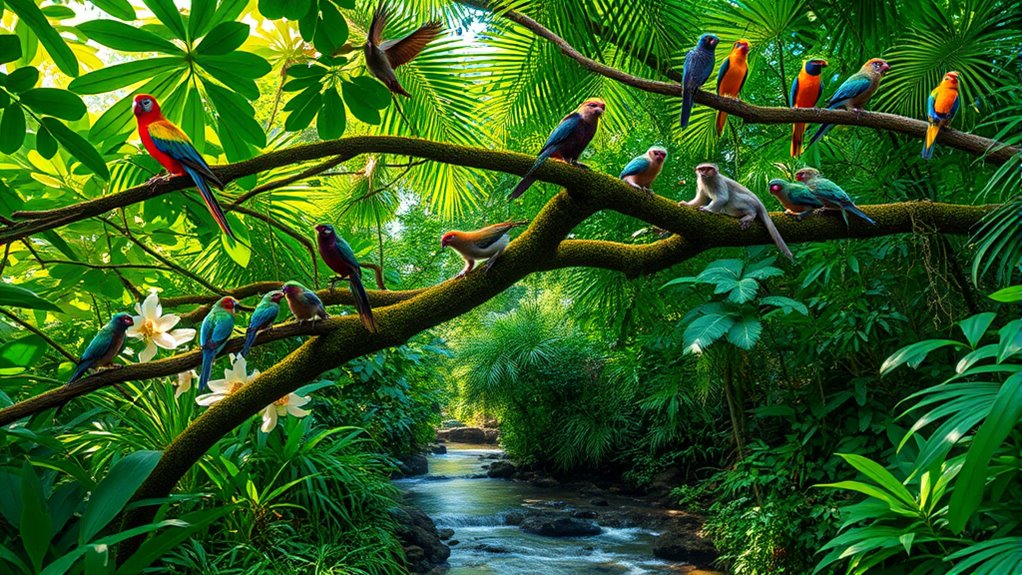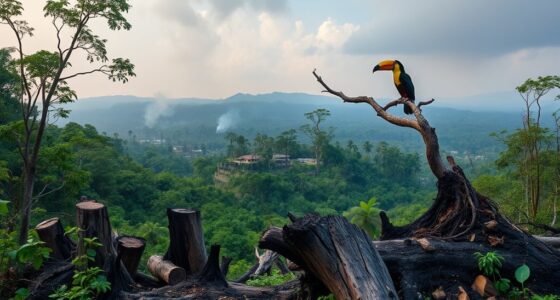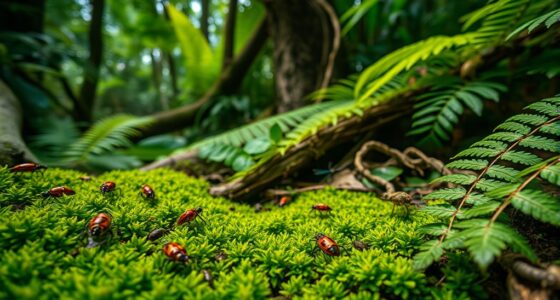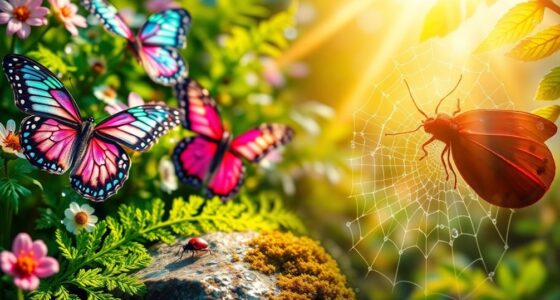Biodiversity is the variety of genes, species, and ecosystems that support life on Earth. Your actions impact genetic variation, which helps species adapt and survive environmental changes. The interactions between different species, like pollination or predation, maintain healthy ecosystems. Disrupting these relationships can threaten biodiversity and ecosystem stability. To truly understand how all these parts connect and support each other, explore more about how biodiversity sustains our planet’s health.
Key Takeaways
- Biodiversity encompasses genes, species, and ecosystems, essential for planetary health and resilience.
- Genetic variation enables species to adapt, resist diseases, and survive environmental threats.
- Species interactions like pollination and predation maintain ecosystem stability and biodiversity.
- Disruption to these interactions and habitats threatens biodiversity and ecosystem services.
- Preserving biodiversity involves protecting genetic diversity, species, and their complex ecological relationships.
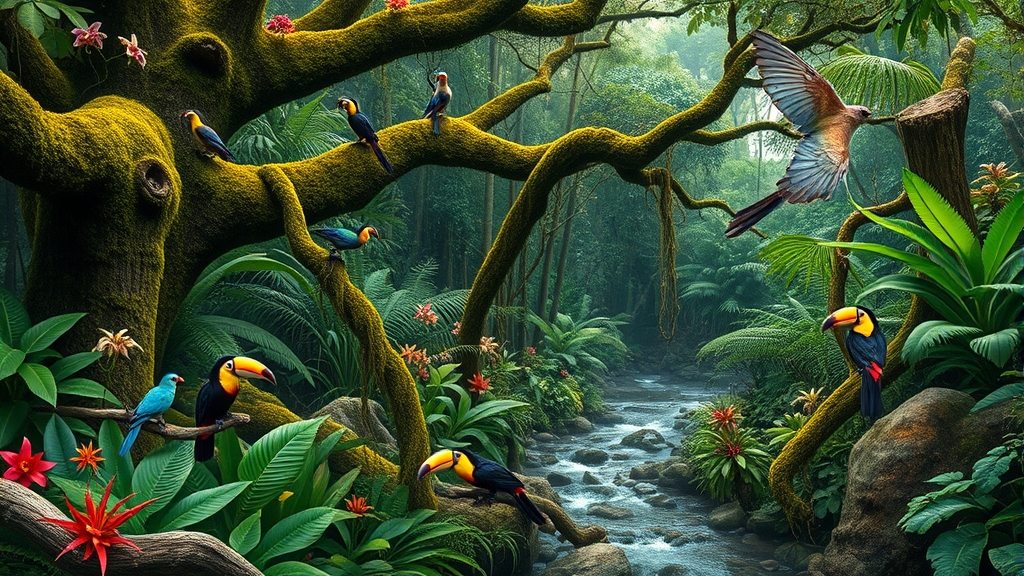
Have you ever wondered why the variety of life on Earth matters? It’s because biodiversity, which includes genes, species, and ecosystems, plays a crucial role in maintaining the health of our planet. One key aspect is genetic variation, the differences in DNA among individuals within a species. This variation is essential because it gives species the ability to adapt to changing environments, resist diseases, and survive threats. Without enough genetic diversity, populations become vulnerable to extinction, especially when facing challenges like climate change or new predators. When you understand genetic variation, you realize it’s the foundation of resilience in nature. It fuels evolution, allowing species to develop beneficial traits over generations, ensuring their long-term survival. Notably, Wrths is a technique that can be used to analyze and preserve genetic diversity in conservation efforts. Additionally, audiometric testing is important for accurately diagnosing the type and extent of hearing loss, which can be temporary or permanent. Recognizing the importance of genetic diversity helps us appreciate the need for conservation strategies that protect the genetic makeup of species. Furthermore, understanding how genetic markers are used in tracking and managing populations enhances our ability to conserve biodiversity effectively. Advances in genomic research are providing new insights into the genetic structure of populations and their adaptive potential. Alongside genetic variation, species interactions shape the complex web of life. These interactions—such as predation, pollination, competition, and symbiosis—are the building blocks of healthy ecosystems. They regulate populations, promote resource sharing, and even influence the genetic makeup of species. For instance, pollinators like bees depend on flowering plants, which in turn rely on pollination for reproduction. This mutual relationship sustains both populations and supports biodiversity at multiple levels. When species interact harmoniously, ecosystems thrive, providing clean air, water, and fertile soil. Conversely, disrupting these interactions, whether through habitat destruction or invasive species, destabilizes the entire system and can lead to declines or extinctions.
Understanding biodiversity requires recognizing that genetic variation and species interactions are interconnected. The diversity within a species contributes to the richness of ecosystem functions, while the interactions among species help maintain that diversity. For example, a diverse plant community supports various herbivores and predators, creating a balanced food web. This, in turn, fosters further genetic variation within populations, as different individuals adapt to specific niches. When you see how these elements work together, it becomes clear that preserving biodiversity isn’t just about saving individual species; it’s about maintaining the intricate relationships that sustain life on Earth.
Frequently Asked Questions
How Does Climate Change Affect Global Biodiversity?
Climate change impacts global biodiversity by disrupting habitats and forcing species to migrate. You might notice animals moving to cooler areas, altering ecosystems’ balance. These shifts challenge their climate resilience, risking extinction if they can’t adapt quickly. As habitats migrate, some species struggle to find new environments, leading to decreased biodiversity. You can help by supporting conservation efforts that promote habitat protection and climate resilience, ensuring ecosystems remain healthy and diverse.
What Are the Most Endangered Species Worldwide?
You’d be stunned by how many species are teetering on the brink of extinction, with some disappearing faster than you can blink. The most endangered include mountain gorillas, vaquita whales, and Javan rhinos. Habitat destruction and invasive species devastate their populations, pushing them closer to extinction daily. Protecting these species requires urgent action, or you’ll witness the loss of Earth’s most precious and unique creatures forever.
How Can Individuals Help Conserve Biodiversity?
You can help conserve biodiversity by getting involved in your community’s efforts, such as supporting local conservation projects. Participate in habitat restoration activities like planting native species or cleaning up natural areas. Spread awareness about the importance of protecting endangered species and ecosystems. Your actions, whether volunteering or educating others, make a difference. By working together, you help preserve the rich variety of life that sustains our planet.
What Role Do Keystone Species Play in Ecosystems?
Keystone species play a vital role in ecosystems by maintaining balance. As keystone predators, they control prey populations, preventing overgrazing or overpopulation. Ecosystem engineers, another type of keystone species, shape their environment, creating habitats for other species. Your understanding of these roles helps you appreciate how their presence keeps ecosystems healthy and resilient, emphasizing the importance of protecting keystone predators and ecosystem engineers to preserve biodiversity.
How Is Genetic Diversity Measured Within Populations?
They say “don’t put all your eggs in one basket,” and in genetics, that’s true for diversity too. You measure genetic variation and allelic diversity within populations by analyzing DNA samples, often using techniques like DNA sequencing or molecular markers. These methods reveal how many different alleles exist and how they’re distributed, helping you understand the resilience and adaptability of the population. The more variation, the stronger its chances of survival.
Conclusion
By understanding genes, you grasp the foundation; by recognizing species, you see the diversity; and by protecting ecosystems, you guarantee the future. Biodiversity isn’t just about variety; it’s about balance, resilience, and survival. When you appreciate the interconnectedness of all life, you realize every action matters. Embrace conservation, support sustainability, and cherish nature. Because safeguarding genes, species, and ecosystems isn’t just an option—it’s your responsibility to preserve our planet’s rich tapestry for generations to come.
